This post may contain affiliate links. Please read our disclosure policy.
Easy Mahi Mahi Recipe with Lemon Garlic Sauce. A simple and wildly delicious way to prepare and serve this tender, flakey, and popular white fish.
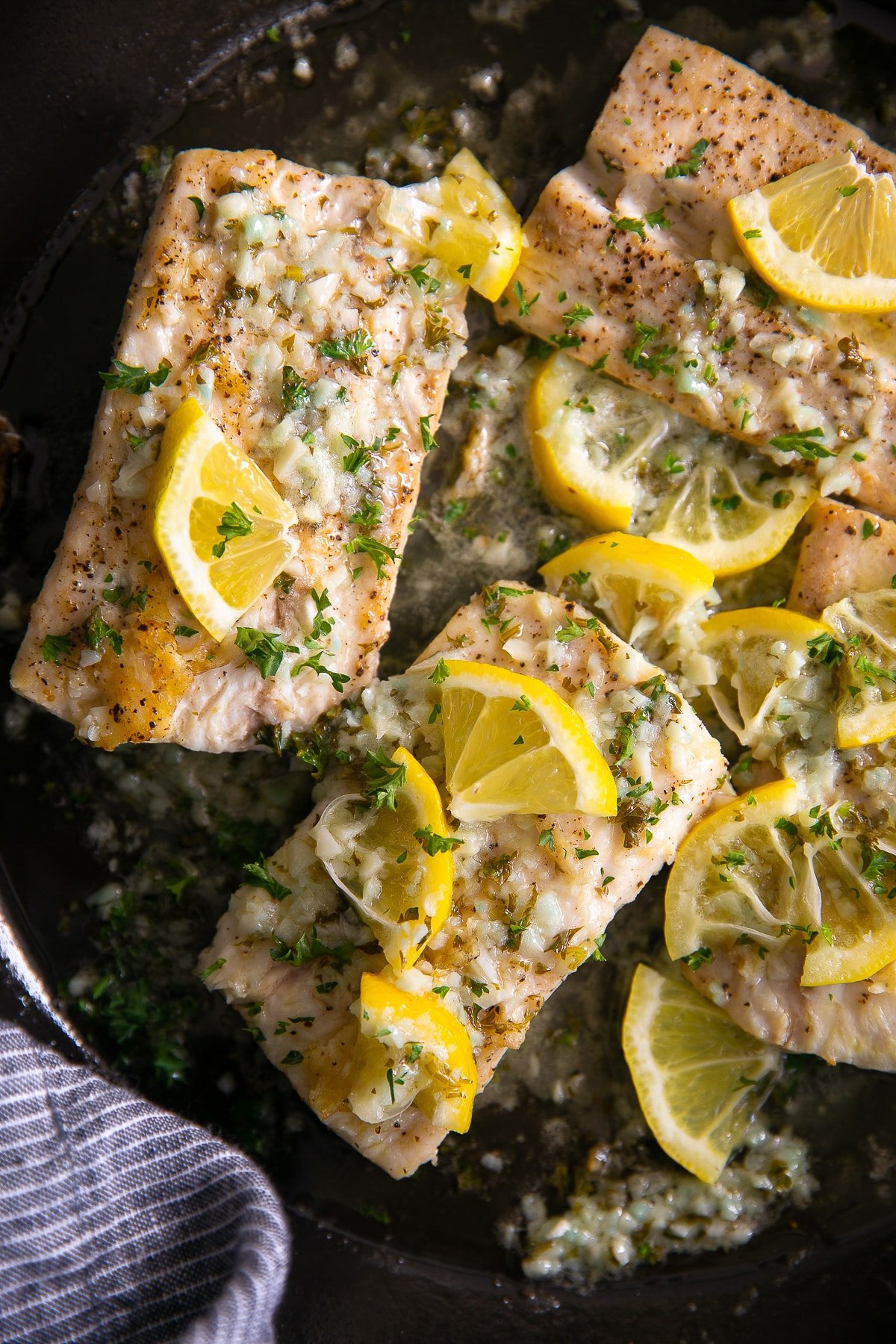
Perfect Mahi Mahi Recipe
Every couple of weeks I get a huge craving for fish. This craving usually evolves into one of a handful of different recipes including fish sticks, baked fish with tomatoes, artichokes, and feta, or some version of pan-seared fish usually served with a big scoop of tartar sauce.
This week, however, I was feeling inspired by my favorite chicken piccata recipe and this (reader favorite) garlic butter sauce. Picking mahi-mahi fish rather than my usual go-to codfish fillets, the result was this easy, 30-minute pan-seared mahi-mahi dinner. Delicious, flavorful, and made with just 7 ingredients – that’s it!
One of my favorite parts about this recipe (aside from the fish, of course) is that it pairs so well with just about everything. From rice to couscous, pasta to potatoes (yes, you really want buttery mashed potatoes here), to every single veggie you can possibly imagine.
Who’s ready to start cooking?
What is Mahi Mahi?
The mahi-mahi, also known as the common dolphinfish (Coryphaena hippurus) or dorado, is a surface-dwelling ray-finned fish commonly found off-shore in the waters around the Gulf of Mexico, Costa Rica, Hawaii, and the Indian Ocean. The name “mahi-mahi” is derived from the Hawaiian word for “very strong”.
Sustainability is determined by a number of factors, the most important being where and how the mahi-mahi is caught.
According to the Monterey Bay Aquarium Seafood Watch,
- Best – mahi-mahi (aka dolphinfish, dorado) caught in the U.S. Atlantic with handlines and hand-operated pole-and-lines or trolling lines.
- Second-best – mahi-mahi caught in the Eastern Central Pacific in the unassociated purse seine fishery or by U.S., Ecuadorian and Panamanian fleets. Understand that there are some issues with at-risk or overfished species in these areas.
- Avoid – All other imported mahi-mahi from the Atlantic, Pacific, and Indian Oceans.
Note: most of the dolphinfish sold in the U.S. is imported which means that most of the mahi-mahi sold in the U.S. is on the avoid list.
Ingredients and Frequently Asked Questions
- Mahi Mahi fillets
- Salt + Pepper
- Olive oil
- Butter
- Whole garlic cloves
- Fresh whole lemons (for juicing and slicing)
- Fresh parsley
Can I use any other white fish to make this recipe?
If you can’t find mahi-mahi, replace it with another type of flakey white fish. My top picks include cod, halibut, and tilapia. Total cooking times may vary slightly depending on the size and overall thickness of your fillets.
Can I grill my mahi-mahi instead?
Instead of pan-searing your mahi-mahi, why not try grilling? Just as quick as cooking on the stovetop, here’s how you’ll do it:
- Preheat your gas grill to medium-high heat (or 450 degrees F).
- Season your fish with salt and pepper, or other desired seasoning (try adding a dash of onion powder or garlic powder or go all-out with your favorite cajun seasoning, blackening seasoning, etc.) and brush both sides with olive oil.
- Place each fillet directly on the grill. Grill for approximately 4-5 minutes per side. It’s fully cooked when it reaches an internal temperature of 137 degrees F.
- Remove from the grill and smother in your homemade garlic butter sauce.
How are leftovers?
First and foremost, don’t try to freeze leftovers and reheat later. Yes, it will be edible, but no, it will not even come close in taste or texture to the original. Your best bet? Store leftovers in a sealed container and in the refrigerator for up to 2-3 days. I typically reheat my fish in the microwave at 30-second intervals until it is just heated through. You will probably notice that your fish isn’t as tender or flakey – that’s normal.
How to Cook Mahi Mahi
1. Season the fillets.
But first, pat each mahi-mahi fillet dry with paper towels. This guarantees that flavorful, golden sear we’re after. Next, season both sides of your fish fillets with salt and lemon pepper or your own combination of seasoning. Options include salt and black pepper, garlic powder, onion powder, and paprika.
2. Prepare the ingredients for the garlic butter sauce.
Once you get started cooking things move pretty fast, so I like to have everything prepared and ready to go before I start.
Wash your lemons. Then, thinly slice one lemon and juice the other lemon into a small bowl so that you have approximately 4 tablespoons of fresh lemon juice. Mince the fresh garlic cloves and set aside.
3. Pan sear the mahi-mahi.
Add the olive oil to a large stainless steel skillet or cast-iron skillet set over medium-high heat. Once the olive oil is nice and hot, carefully add each fillet. Sear, undisturbed, until nicely golden brown and the sides are cooked just past halfway up the fillets. This will take about 4 minutes depending on the thickness of your fish (the fish is cooked when it’s no longer opaque-looking).
Flip and continue to cook on the other side until just cooked through, about 2-4 minutes more (mahi-mahi should reach an internal temperature of 137°F). Remove from heat and transfer fillets to a serving plate.
4. Prepare the lemon garlic sauce.
Immediately start the sauce. In the same skillet (or in a new one), heat the butter, lemon juice, and lemon slices over medium heat. Heat until the butter is melted and just starting to bubble. Stir in the garlic, reduce heat to low, and continue to cook for 1 minute, or until the garlic is lightly golden. Stir in the fresh minced parsley and drained capers (optional).
5. Combine and serve.
Spoon the garlic butter sauce over the mahi-mahi and serve immediately with all your favorite side dishes.
What to Serve with Mahi Mahi?
There are so many great things to serve with this mahi-mahi recipe. A few healthy favorites include brown rice, wild rice, or even cauliflower rice. Dry something a little creamier like buttery mashed potatoes or (my favorite) low-carb cauliflower mashed potatoes. Of course, when in doubt, big chunks of warm bread are always fantastic dunked in some extra butter sauce.
Add some greens with a light salad, roasted beets, or steamed veggies of any kind.
More Fish Recipes,
- Fish Ceviche Recipe (How to Make Ceviche)
- Pineapple Coconut Thai Fish Curry
- Mediterranean Baked Fish
- Jamaican Jerk Cod
- Norwegian Salt Cod Stew (Bacalao)
If you try making this Easy Mahi Mahi Recipe, please leave me a comment and let me know! I always love to hear your thoughts.
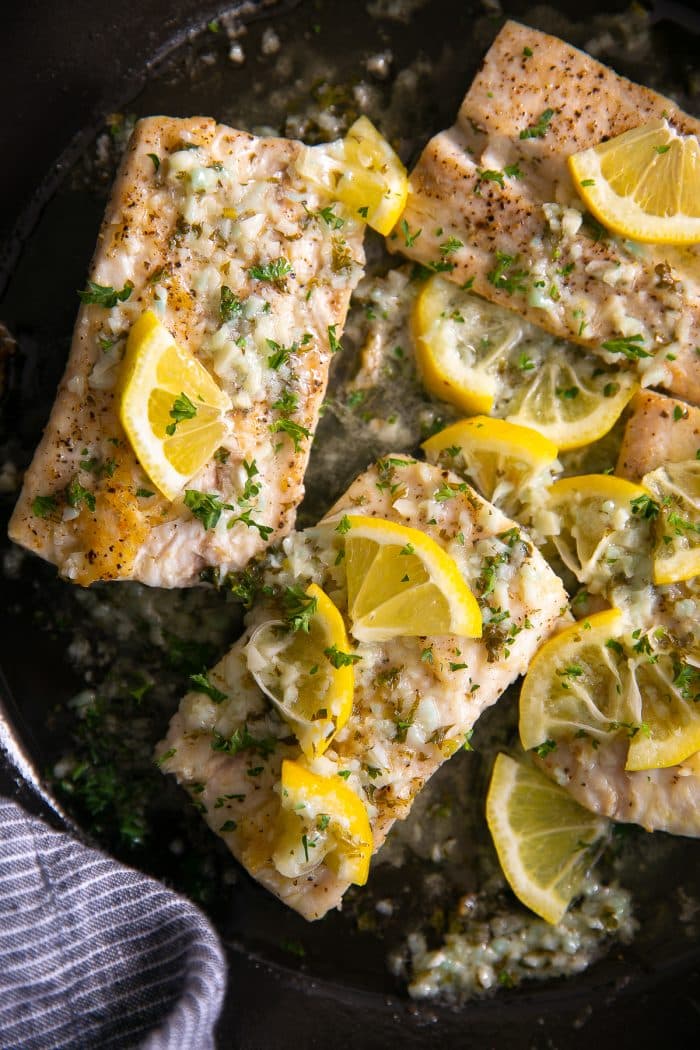
Mahi Mahi Recipe with Lemon Garlic Sauce
Ingredients
Instructions
- Season the mahi mahi. Gently pat each mahi-mahi fillet dry with paper towels and generously season both sides of each fillet with salt and lemon pepper. Set aside.
- Prepare the ingredients for the Lemon garlic sauce. Thinly slice one lemon and juice the other lemon into a small bowl so that you have approximately 4 tablespoons of fresh lemon juice. Mince the garlic and set it aside so that it is already ready for when it's time to cook the butter sauce.
- Pan sear the mahi mahi. Add the olive oil to a large skillet set over medium-high heat. Once the olive oil is nice and hot, carefully add each fillet. Sear, undisturbed, until nicely golden brown on the bottom, and the sides are cooked just past halfway up the fillets, about 4 minutes depending on the thickness of your fish (the fish is cooked when it's no long opaque-looking). Flip and continue to cook on the other side until just cooked through, about 2-4 minutes more (mahi-mahi should reach an internal temperature of 137°F). Remove from heat and transfer fillets to a serving plate.
- Prepare the garlic butter sauce. In the same skillet (or in a new one), heat the butter, lemon juice, and lemon slices over medium heat. Heat until the butter is melted and just starting to bubble. Stir in the garlic, reduce heat to low, and continue to cook for 1 minute, or until the garlic is lightly golden. Stir in the fresh minced parsley and drained capers (optional).
- Combine and serve. Spoon the garlic butter sauce over the mahi-mahi and serve immediately.
Notes
Nutrition
Nutrition information is automatically calculated, so should only be used as an approximation.
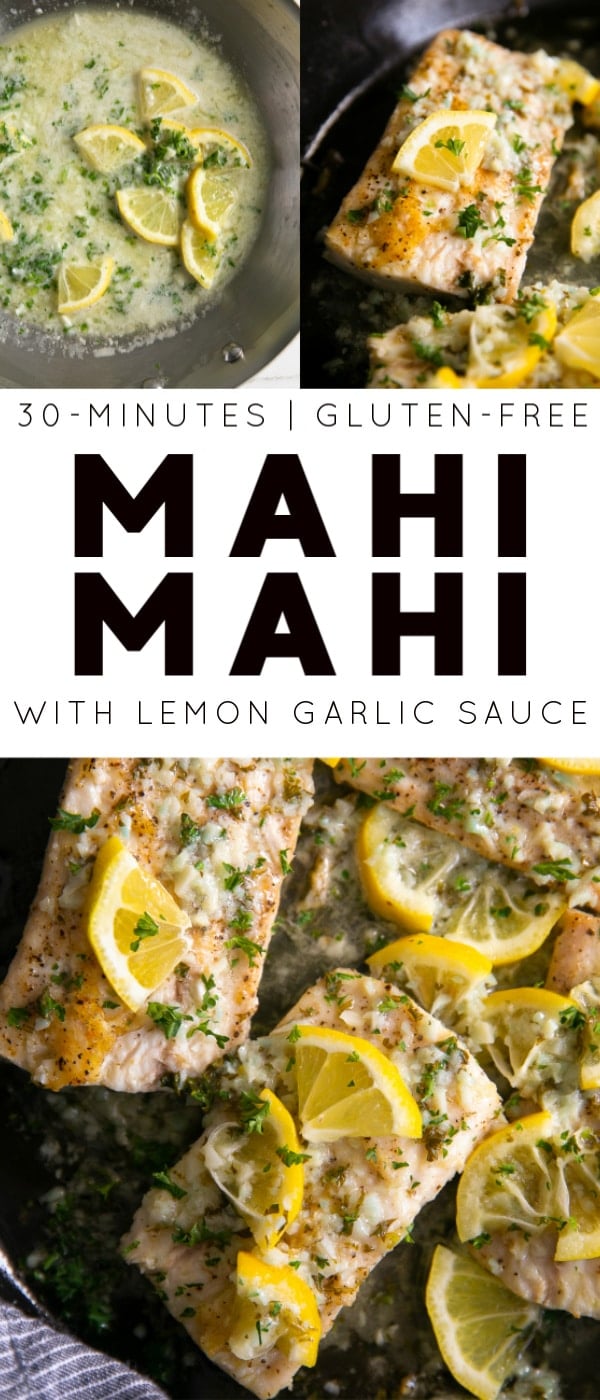
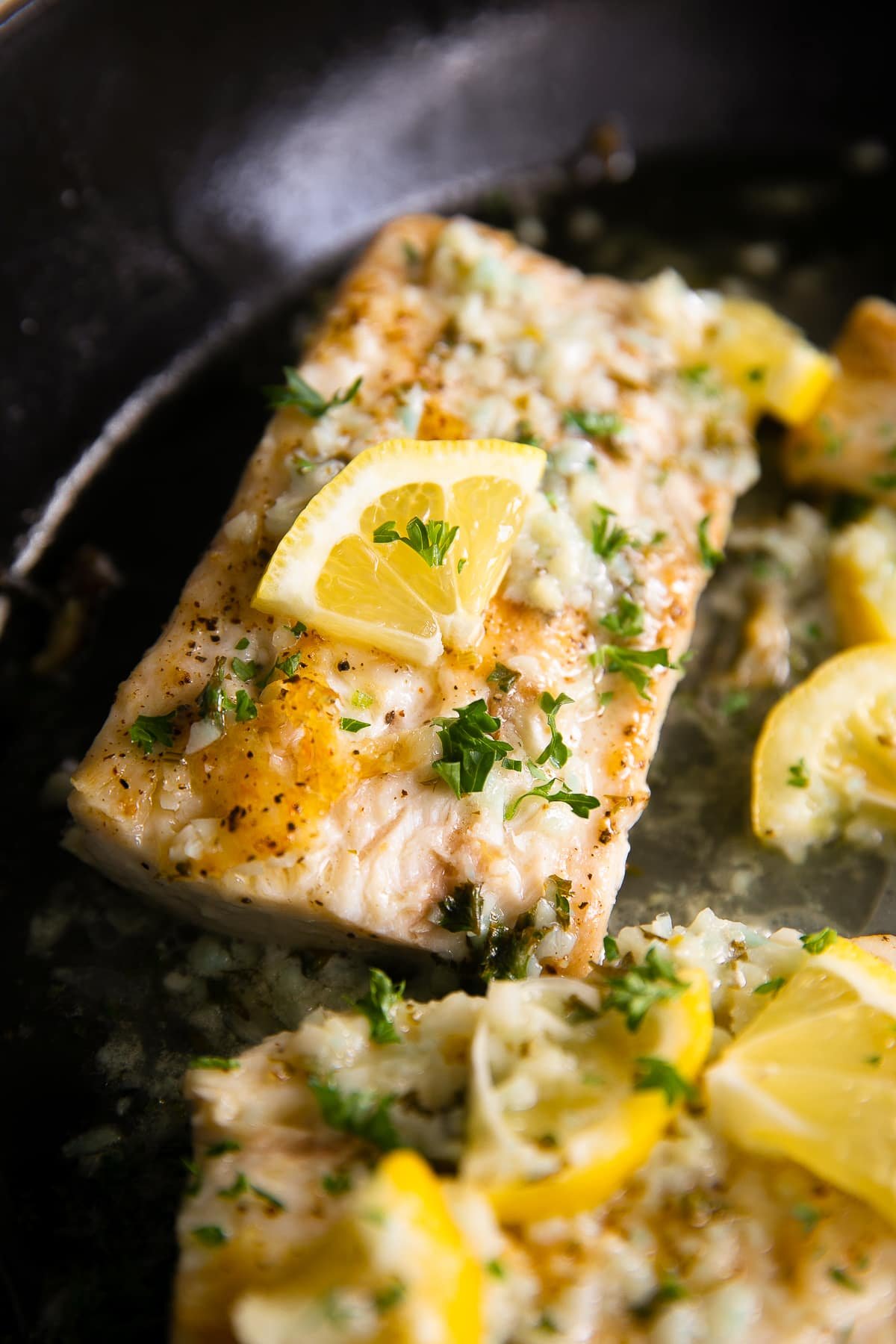
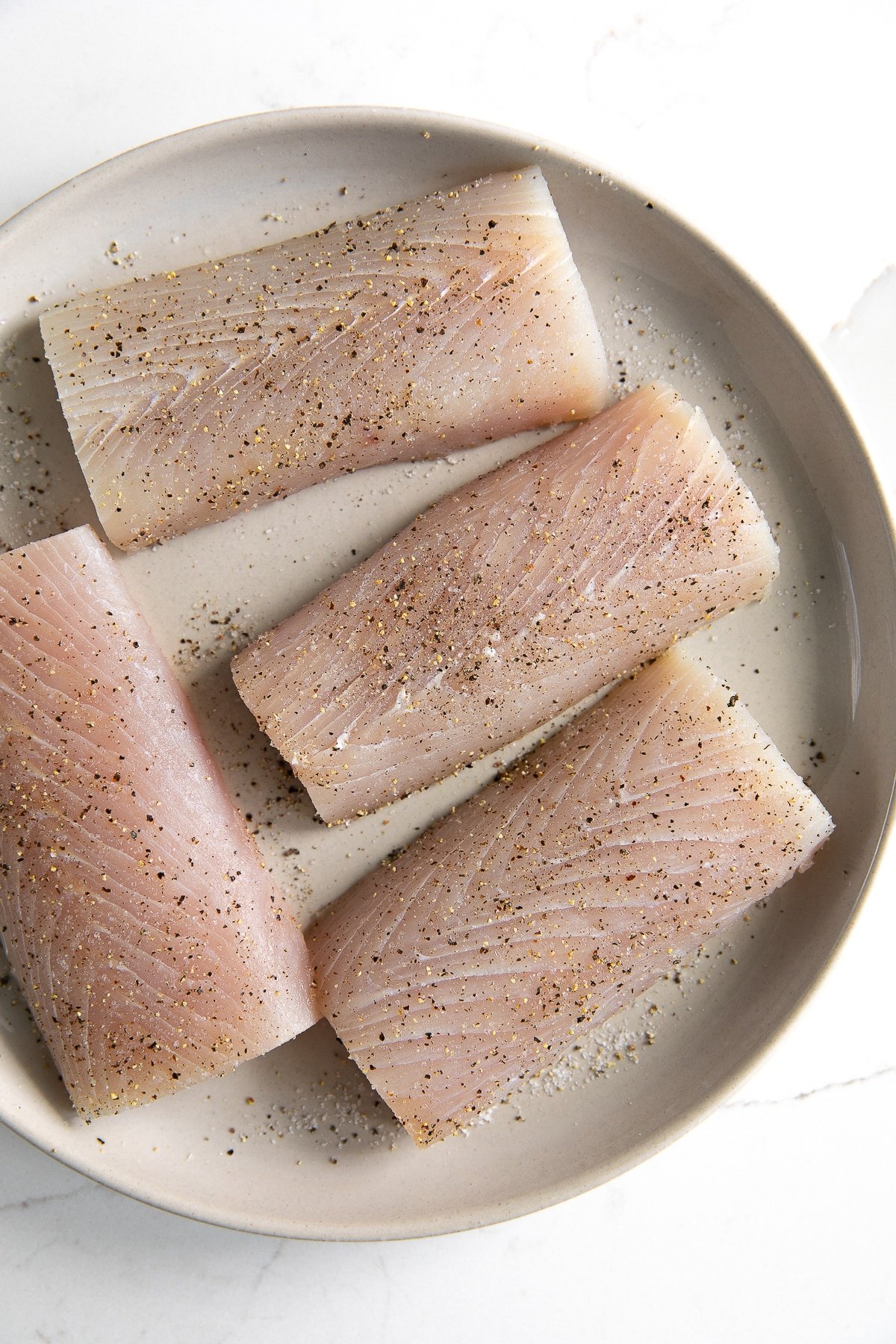
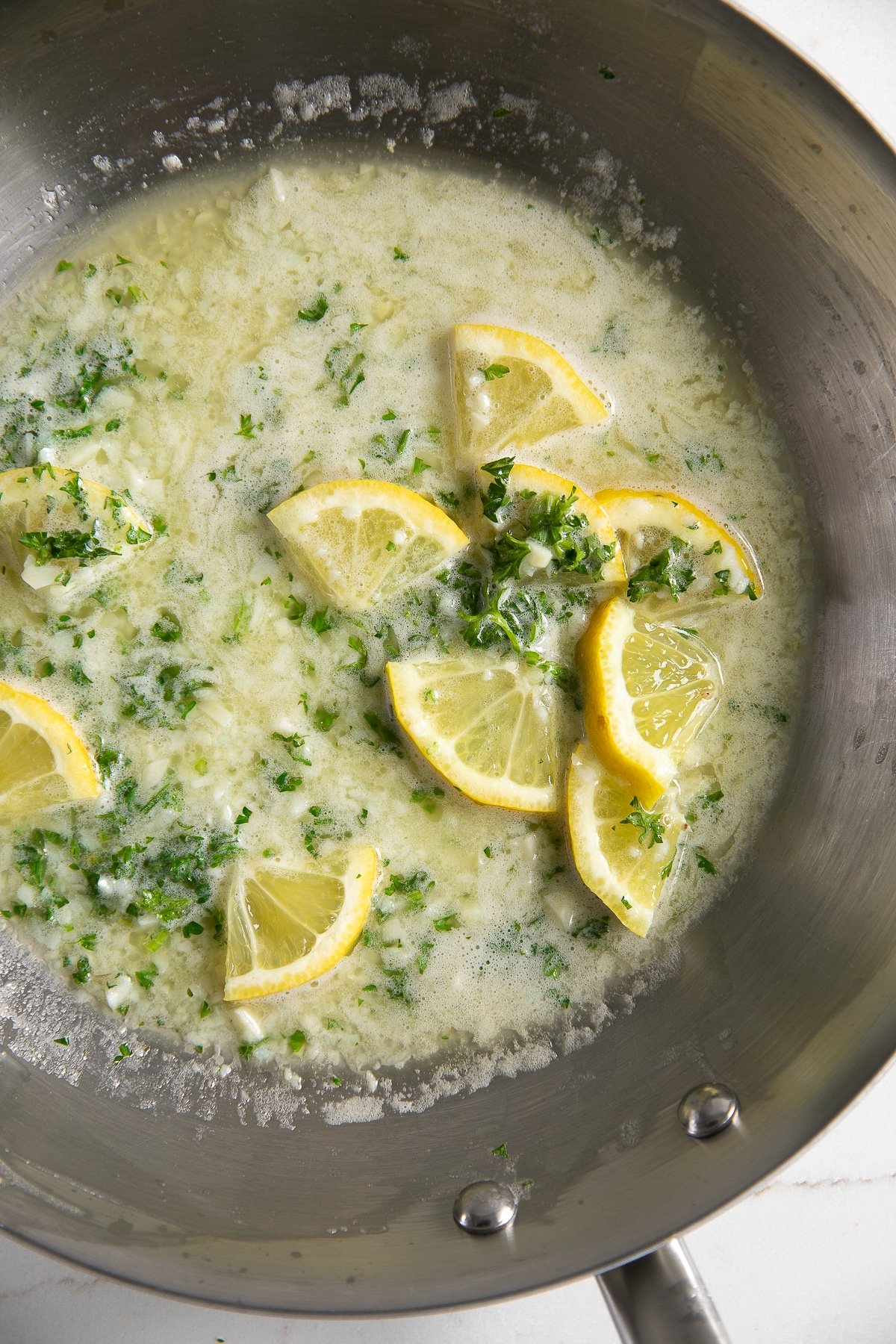
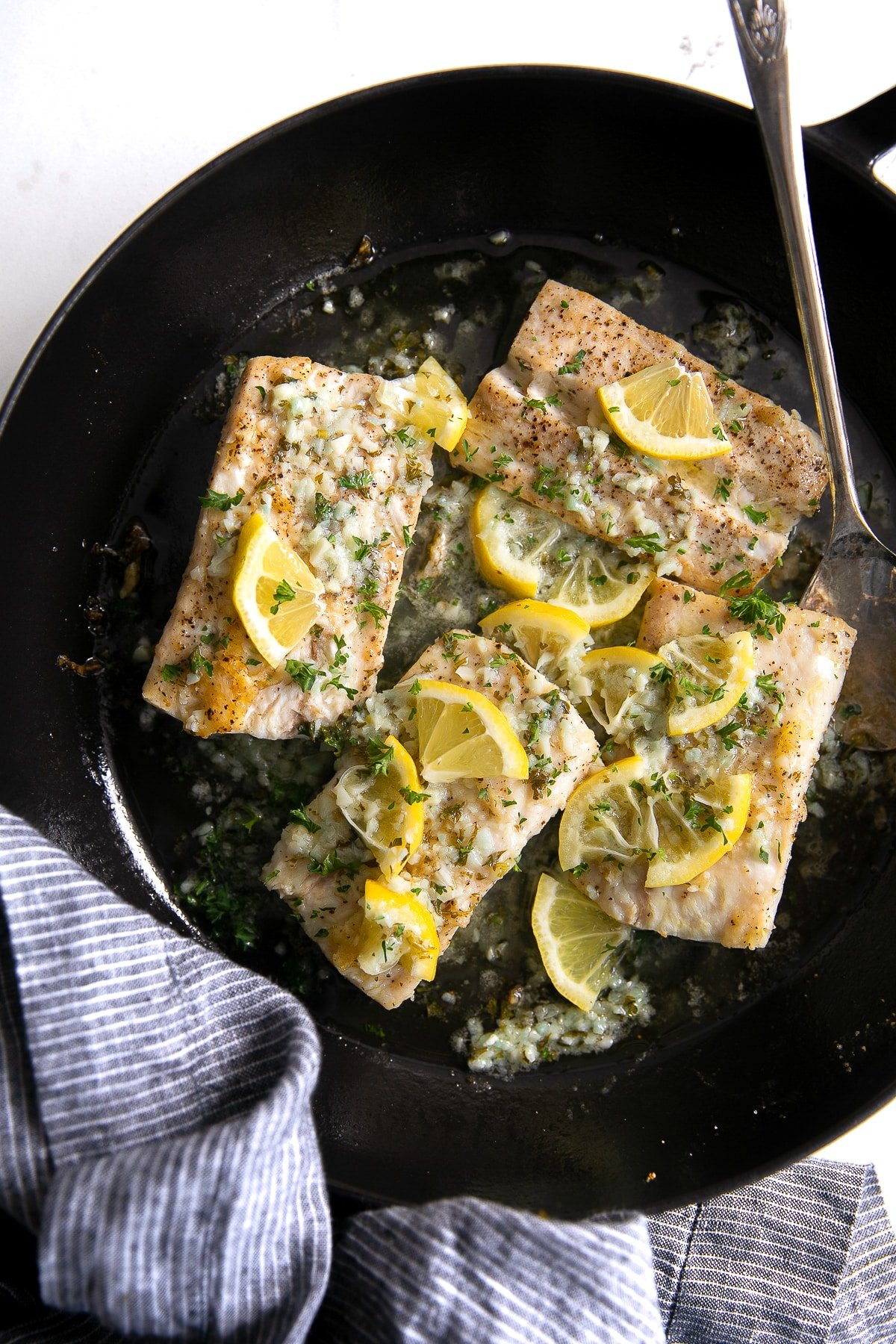
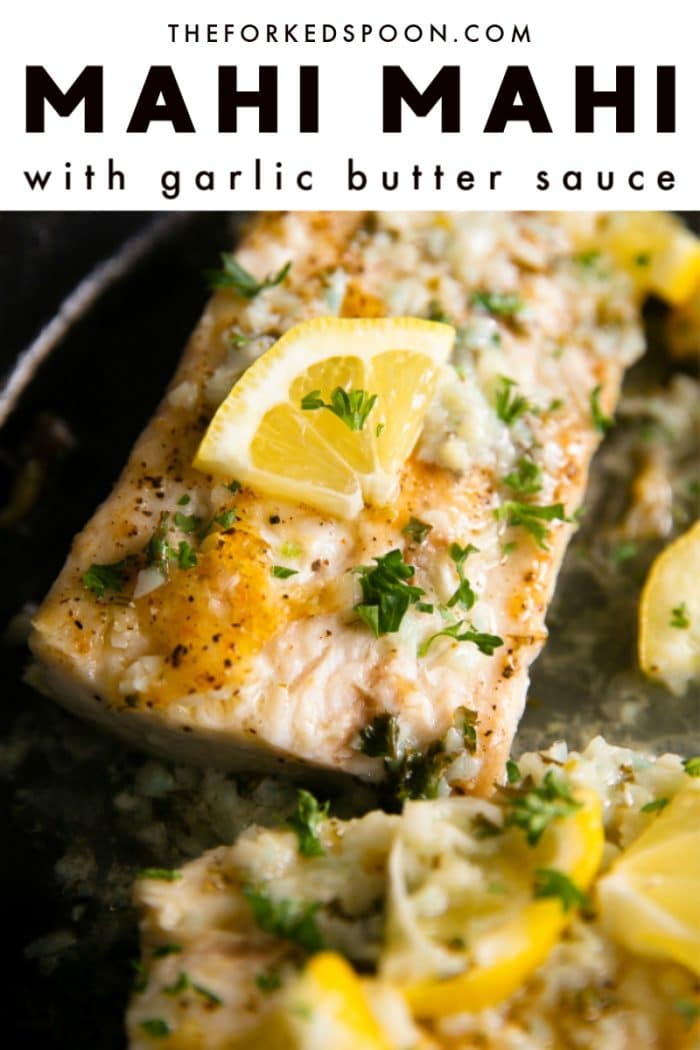
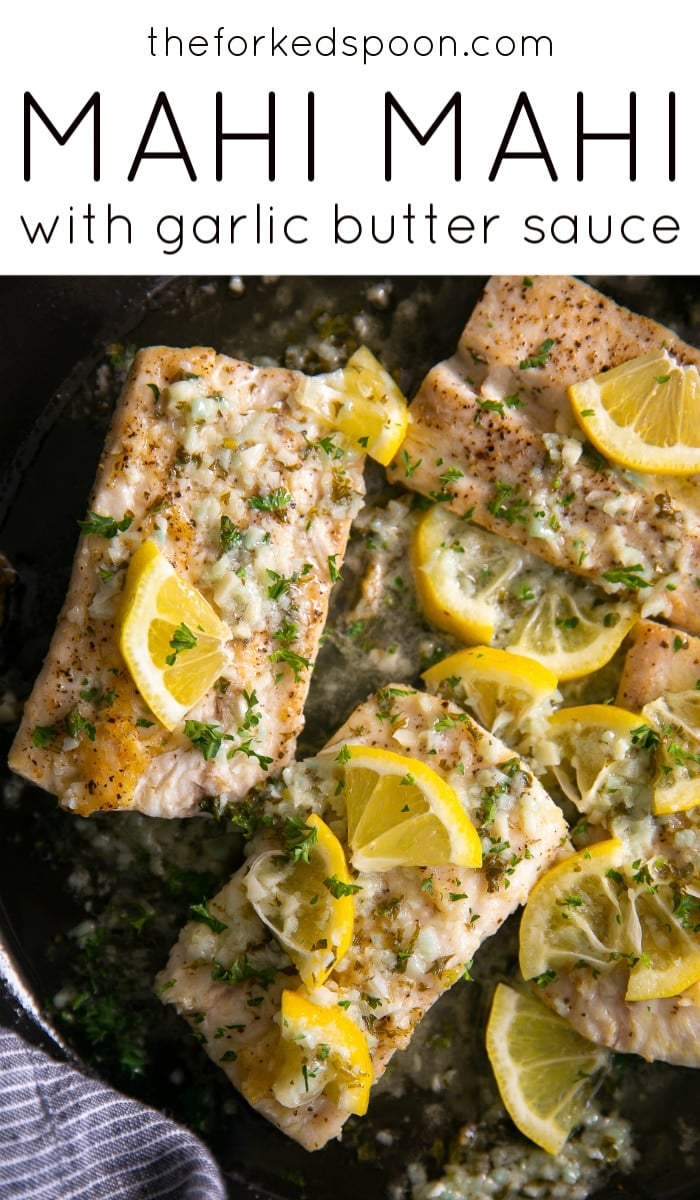

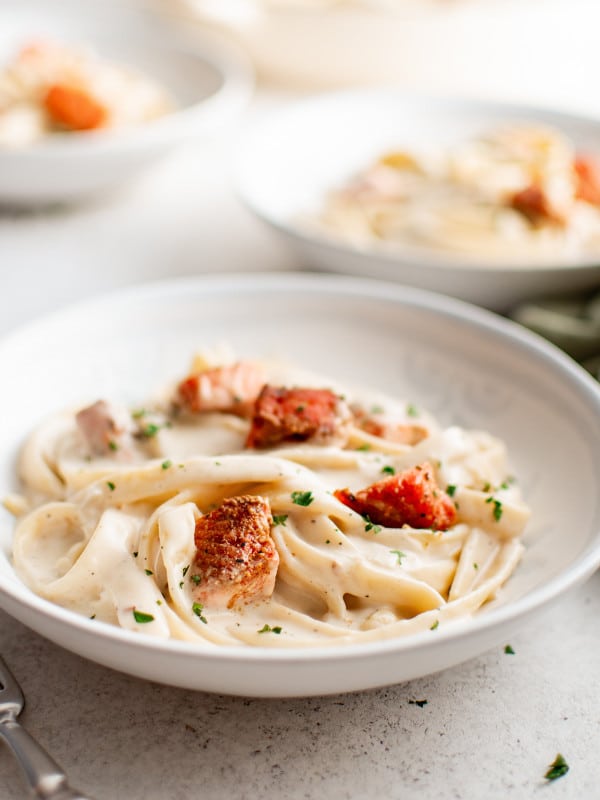
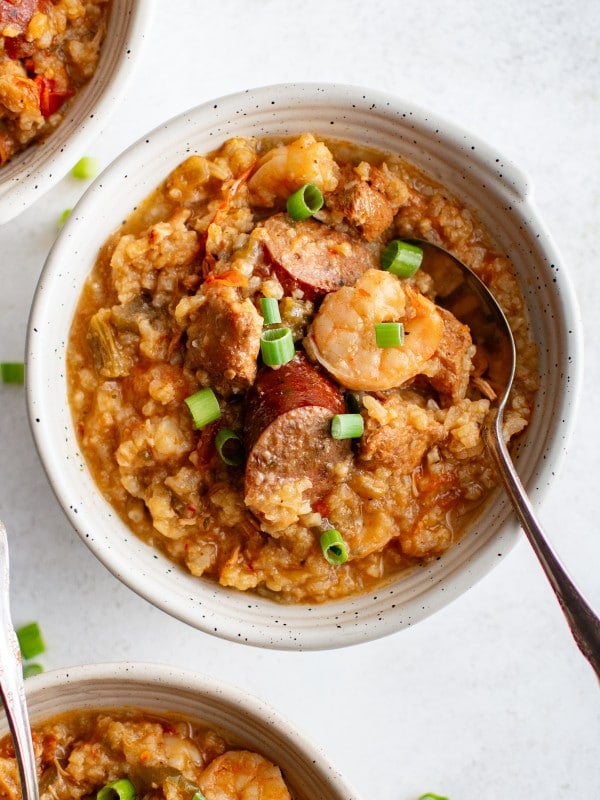
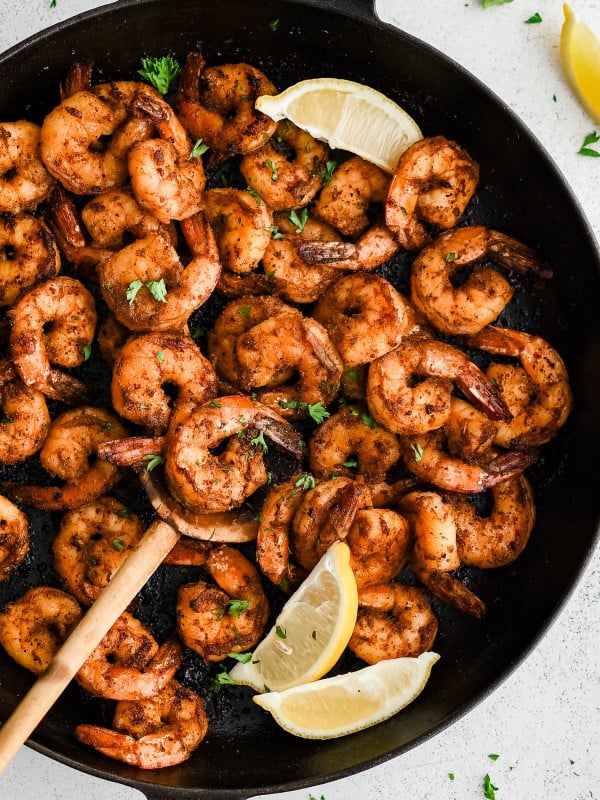









Very Good ! Fish was firm and tasty. The Lemon Butter Garlic Sauce was excellent.
I’m wondering what else I can use the Sauce with.!
Thank you so much for your comment! I’m glad you enjoyed the mahi mahi and loved the Lemon Butter Garlic Sauce—it’s one of my favorites too. This sauce is super versatile and pairs perfectly with shrimp, scallops, salmon, chicken, or even drizzled over roasted vegetables.
Received many compliments for this dish. Made it twice in one week for different people.
It’s a keeper and I’ll use it often.
Thank you so much for your feedback! I’m thrilled to hear the recipe was such a hit and that you’ve already made it more than once. Knowing it’s become a keeper in your kitchen truly makes my day—thanks for sharing!
The confusion between mahi mahi and dolphins (the mammals) is one of those unfortunate naming quirks that’s caused a lot of unnecessary distress over the years.
Mahi Mahi is the Hawaiian name for a fast-swimming, surface-dwelling fish scientifically known as Coryphaena hippurus. It’s also called dolphinfish in some regions—not because it’s related to dolphins (it’s not at all), but likely due to its energetic swimming style and the old Florida Keys fishing vernacular. The term “dolphinfish” predates widespread awareness of the confusion it might cause, and thankfully, most restaurants and markets now use “mahi mahi” to avoid exactly this kind of misunderstanding.
That’s such a great point! I’ve always loved dolphins too, so I totally get the confusion—and concern—over the name. Thankfully, using “mahi mahi” helps everyone know exactly what they’re ordering or cooking, with no worry about dolphins being involved. Thanks again for sharing your insight!
I love to cook, and used to love fish and seafood. But can’t stand it anymore. I did buy some Mahi Mahi at BJ’s yesterday, as I remember I loved it . I followed your recipe, and it is awesomely delicious ! Thank you for the great recipe.My husband loves it too.
Thank you so much for sharing this, it truly made my day! I’m so glad you gave mahi mahi another chance and enjoyed the recipe—even more special that your husband loved it too. Comments like yours inspire me to keep creating new dishes. If you ever need more seafood ideas, don’t hesitate to reach out!